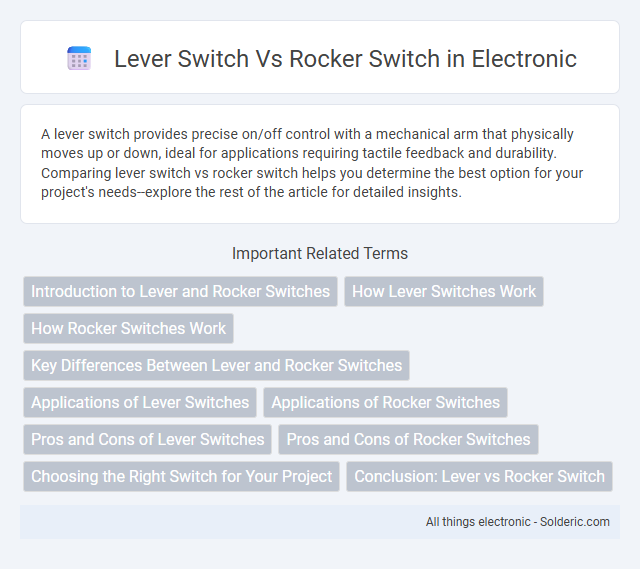A lever switch provides precise on/off control with a mechanical arm that physically moves up or down, ideal for applications requiring tactile feedback and durability. Comparing lever switch vs rocker switch helps you determine the best option for your project's needs--explore the rest of the article for detailed insights.
Comparison Table
| Feature | Lever Switch | Rocker Switch |
|---|---|---|
| Operation | Manual lever moved up/down or side to side | Rocker mechanism rocks back and forth |
| Design | Elongated lever handle | Flat or curved paddle surface |
| Applications | Industrial machinery, automotive controls | Household appliances, power strips |
| Durability | High, suitable for heavy use | Moderate, suited for light to medium use |
| Feedback | Distinct tactile feedback | Smoother tactile feedback |
| Installation | Usually panel-mounted with screws | Snap-in or panel-mounted |
| Cost | Generally higher | Generally lower |
Introduction to Lever and Rocker Switches
Lever switches and rocker switches are commonly used electrical components designed to control circuits by toggling between on and off positions. Lever switches feature a protruding handle that is manually flipped to open or close a circuit, providing clear tactile feedback. Rocker switches operate by rocking a button back and forth, offering a compact design ideal for panel mounting in automotive, industrial, and electronic applications.
How Lever Switches Work
Lever switches operate by physically moving a lever arm to open or close an electrical circuit, allowing current to flow or stopping it. When the lever is pushed or pulled, it changes the position of internal contacts, creating a reliable on/off connection. These switches are commonly used in applications requiring clear visual and tactile feedback of circuit status.
How Rocker Switches Work
Rocker switches operate by tilting a pivoting mechanism to open or close an electrical circuit, allowing current to flow or stop. Pressing one side of the switch rocks it into the "on" or "off" position, making contact with internal terminals that control power to the device. These switches are widely used for their durability, ease of operation, and clear visual indication of circuit status.
Key Differences Between Lever and Rocker Switches
Lever switches feature a protruding handle that moves up and down or side to side to control electrical circuits, offering clear tactile feedback. Rocker switches operate by rocking a hinged plate, providing a flat surface that pivots to open or close the circuit, often used in appliances for easy finger operation. Lever switches are preferred for precise mechanical control in industrial settings, while rocker switches are favored for sleek design and ergonomic use in consumer electronics.
Applications of Lever Switches
Lever switches are commonly used in industrial machinery, HVAC systems, and automotive controls due to their robust design and precise mechanical operation. Their ability to handle high currents and provide clear on/off positions makes them ideal for heavy-duty applications requiring reliable manual control. You can find lever switches in conveyor belts, elevators, and power tools where durable and straightforward switching is essential.
Applications of Rocker Switches
Rocker switches are commonly used in household appliances, power strips, and automotive dashboards due to their durability and ease of operation. Their ability to provide clear on/off positions makes them ideal for controlling electrical circuits in devices such as lamps, computer power supplies, and audio equipment. You can rely on rocker switches for consistent performance in both residential and industrial applications.
Pros and Cons of Lever Switches
Lever switches offer precise control and a clear tactile response, making them ideal for applications requiring reliable on/off functionality. Their simple mechanical design ensures durability and ease of repair, but they can be bulkier than rocker switches, potentially limiting their use in compact devices. Lever switches may also be less aesthetically versatile, often not blending seamlessly into modern consumer electronics.
Pros and Cons of Rocker Switches
Rocker switches offer a sleek design and reliable operation, making them ideal for modern electronic devices with limited space. Their ease of use allows you to quickly toggle power, but they may be less tactile than lever switches, potentially reducing feedback during operation. While rocker switches are generally more durable and resistant to accidental activation, they can be slightly more expensive and less intuitive for users accustomed to lever mechanisms.
Choosing the Right Switch for Your Project
Selecting between a lever switch and a rocker switch depends on your project's specific needs for tactile feedback, space constraints, and switching action. Lever switches offer precise control with a mechanical toggle that suits applications requiring clear on/off positions, while rocker switches provide a compact, easy-to-use design ideal for panel mounting and frequent operation. Understanding the electrical ratings and installation requirements of each switch type ensures your project achieves reliable performance and user satisfaction.
Conclusion: Lever vs Rocker Switch
Lever switches offer precise, tactile control ideal for applications requiring distinct on/off positions, while rocker switches provide a compact design with ease of use suited for modern electronics and appliances. Lever switches are often favored in industrial settings for their durability and clear actuation feedback, whereas rocker switches are preferred in consumer devices for their sleek appearance and simple operation. Choosing between lever and rocker switches depends on factors such as space constraints, user interaction preferences, and environmental conditions.
lever switch vs rocker switch Infographic

 solderic.com
solderic.com